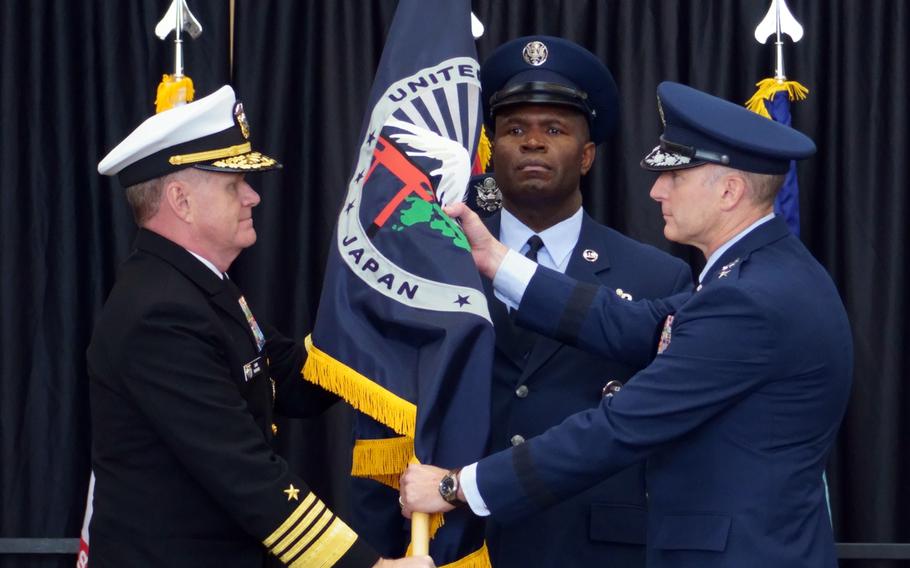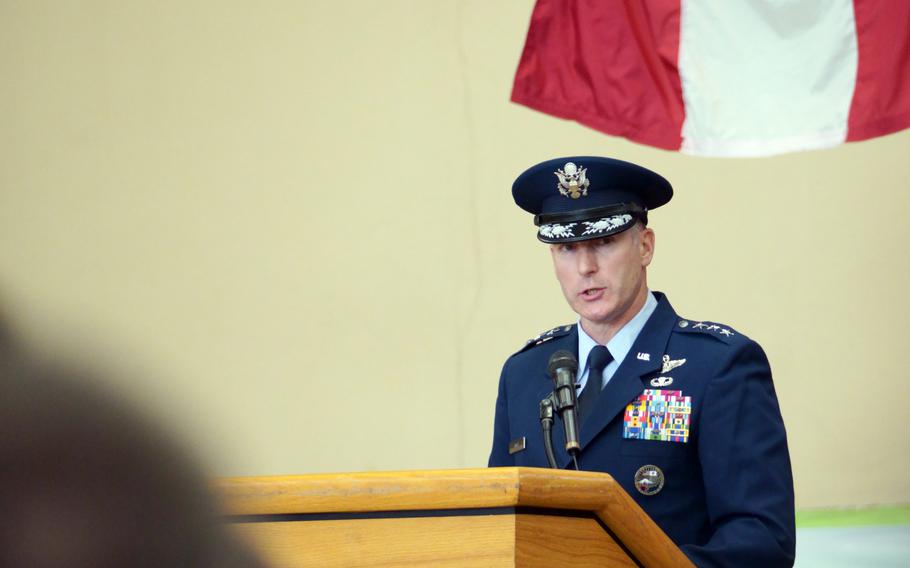
Air Force Lt. Gen. Stephen Jost accepts the U.S. Forces Japan guidon from the head of U.S. Indo-Pacific Command, Adm. Samuel Paparo, at Yokota Air Base, Japan, Oct. 8, 2024. (Akifumi Ishikawa/Stars and Stripes)
YOKOTA AIR BASE, Japan — A fighter pilot with experience in Asia and the Middle East took command of U.S. Forces Japan on Tuesday as it moves toward a joint force headquarters in a tightening alliance with its host nation.
Air Force Lt. Gen. Stephen Jost took over for Lt. Gen. Ricky Rupp in a ceremony presided over by U.S. Indo-Pacific Command chief Adm. Samuel Paparo in a hangar on Yokota’s flight line. Dignitaries, including U.S. Ambassador to Japan Rahm Emanuel, and troops from both nations were also in attendance.
The command change comes as USFJ, which oversees about 115,000 troops, civilians and family members in Japan, prepares to “reconstitute” as a joint force headquarters, Paparo told those gathered for the ceremony.
The change announced by Defense Secretary Lloyd Austin in July will modernize USFJ’s structure to serve as a counterpart to Japan’s Self-Defense Forces Joint Operations Command.
“The decision to reconstitute USFJ, to expand its mission and operational responsibility will be the most significant change to USFJ since its creation and one of the strongest improvements to the alliance’s military cooperation in the Indo-Pacific in 70 years,” Paparo said at the ceremony.
The reorganization comes amid concern about China’s rapid military buildup and aggression toward Taiwan and neighboring countries such as the Philippines over disputed territory in the South and East China seas.
USFJ is a liaison with Japan for the Army, Navy, Air Force and Marine Corps and helps manage the nations’ military alliance. It has authority over basing issues and the status of forces agreement, which governs the legal rights and responsibilities of U.S. military personnel in the country.
The USFJ commander also leads the 15,000 airmen under 5th Air Force at three bases: Yokota, Misawa and Kadena. Fifth Air Force provides a fighter deterrent to would-be adversaries as well as airlift, combat and other aviation capabilities for the U.S. and Japanese militaries.
The Air Force in July announced plans to beef up 5th Air Force by replacing aging F-15 Eagle fighters at Kadena with advanced F-15EX fighters and its F-16 Fighting Falcons at Misawa with advanced F-35C stealth multirole fighters.
Jost is a 1994 graduate of the Air Force Academy with more than 2,700 flight hours, including in the F-16 and F-35A, according to his official biography.
During the change of command ceremony inside a hangar at this airlift hub, Jost’s name was unveiled on the side of his new Fighting Falcon parked nearby.
In remarks to reporters at the Yokota Officers’ Club afterward, Jost said the U.S.-Japan alliance is built on the foundation of a shared mission and common values.
The nations stand side by side in upholding a free and open Indo-Pacific and the rule of law, he said.
“The future is uncertain, and it’s not predestined,” he said. “Therefore, we are working nonstop with our [Japan Self-Defense Forces] colleagues to deepen our partnership and sharpen our collective readiness.”
In addition to service in Iraq and at Kunsan Air Base, South Korea, Jost was stationed at Misawa from July 2011 to June 2012 as deputy commander of the 35th Operations Group and again from July 2012 to December 2012 as director of staff for the 35th Fighter Wing.
Previously, he led Joint Enabling Capabilities Command of U.S. Transportation Command in Norfolk, Va.
Rupp, a former C-130E Hercules and C-17 Globemaster III airlift pilot who led USFJ through the coronavirus pandemic, was awarded his second Distinguished Service Medal for exceptionally meritorious service in a duty of great responsibility, at the ceremony.
The recent inductee into the Pacific Air Forces Order of the Sword — enlisted airmen’s highest form of recognition to an officer — is retiring and will return to his native Texas after 35 years in uniform.

Lt. Gen. Stephen Jost gives his first remarks as commander of U.S. Forces Japan and 5th Air Force at Yokota Air Base in western Tokyo, Oct. 8, 2024. (Akifumi Ishikawa/Stars and Stripes)